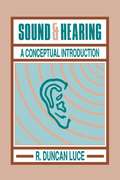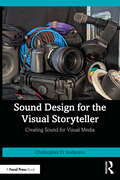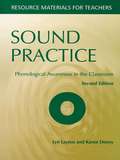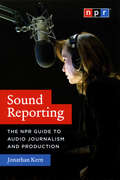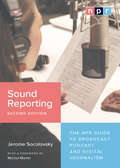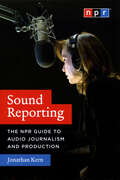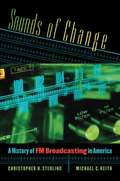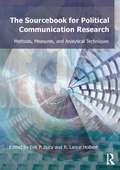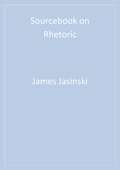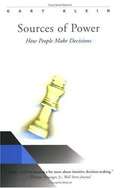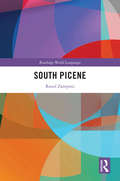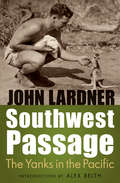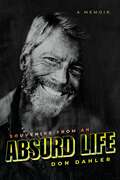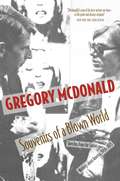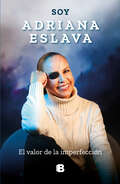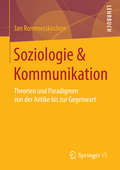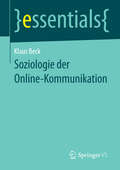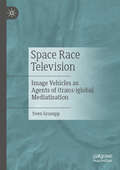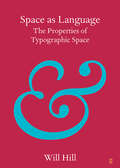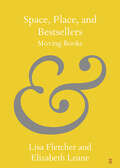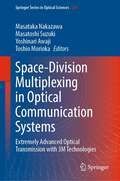- Table View
- List View
Sound & Hearing: A Conceptual Introduction
by R. Duncan LuceThe major aim of this book is to introduce the ways in which scientists approach and think about a phenomenon -- hearing -- that intersects three quite different disciplines: the physics of sound sources and the propagation of sound through air and other materials, the anatomy and physiology of the transformation of the physical sound into neural activity in the brain, and the psychology of the perception we call hearing. Physics, biology, and psychology each play a role in understanding how and what we hear. The text evolved over the past decade in an attempt to convey something about scientific thinking, as evidenced in the domain of sounds and their perception, to students whose primary focus is not science. It does so using a minimum of mathematics (high school functions such as linear, logarithmic, sine, and power) without compromising scientific integrity. A significant enrichment is the availability of a compact disc (CD) containing over 20 examples of acoustic demonstrations referred to in the book. These demonstrations, which range from echo effects and filtered noise to categorical speech perception and total more than 45 minutes, are invaluable resources for making the text come alive.
Sound Business
by Michael StammAmerican newspapers have faced competition from new media for over ninety years. Today digital media challenge the printed word. In the 1920s, broadcast radio was the threatening upstart. At the time, newspaper publishers of all sizes turned threat into opportunity by establishing their own stations. Many, such as the Chicago Tribune's WGN, are still in operation. By 1940 newspapers owned 30 percent of America's radio stations. This new type of enterprise, the multimedia corporation, troubled those who feared its power to control the flow of news and information. In Sound Business, historian Michael Stamm traces how these corporations and their critics reshaped the ways Americans received the news.Stamm is attuned to a neglected aspect of U.S. media history: the role newspaper owners played in communications from the dawn of radio to the rise of television. Drawing on a wide array of primary sources, he recounts the controversies surrounding joint newspaper and radio operations. These companies capitalized on synergies between print and broadcast production. As their advertising revenue grew, so did concern over their concentrated influence. Federal policymakers, especially during the New Deal, responded to widespread concerns about the consequences of media consolidation by seeking to limit and even ban cross ownership. The debates between corporations, policymakers, and critics over how to regulate these new kinds of media businesses ultimately structured the channels of information distribution in the United States and determined who would control the institutions undergirding American society and politics.Sound Business is a timely examination of the connections between media ownership, content, and distribution, one that both expands our understanding of mid-twentieth-century America and offers lessons for the digital age.
Sound Design for the Visual Storyteller: Creating Sound for Visual Media
by Christopher D. AndersonSound Design for the Visual Storyteller is an overview of the sound design process for the beginner filmmaker or storyteller, providing the foundational knowledge needed to succeed at utilizing and designing sound for visual stories, films, and even podcasts.With a focus on television and film, alongside references to podcast, theatre, event, and game sound design, this all-in-one overview begins with the fundamentals of sound and the structure of a professional sound design team, before exploring the practical topics of post-production, creative workflows, and distribution. Supported by a plethora of audio and video examples to demonstrate key concepts, this book guides aspiring sound designers on the power and production value of the well-conceived soundtrack and showcases some of the most effective techniques for getting there.This is an ideal introduction for storytellers working in a range of contexts, including filmmakers, sound designers, and sound editors, as well as students of sound for film and broadcast.
Sound Practice: Phonological Awareness in the Classroom (Resource Materials For Teachers Ser.)
by Lyn Layton Karen DeenyThe second edition of Sound Practice looks afresh at how young children can be helped to discover basic facts about an alphabetic spelling system, within the context of their developing spoken language. It examines why children might fail to understand letter-sound links; the origins of severe and persistent difficulties with achieving functional literacy skills; and developmental processes underpinning the areas of learning identified in national initiatives for promoting children's learning. The book also discusses the need for differentiation strategies to respond to individual children's learning needs within national initiatives, and techniques and approaches that can be effectively applied to fulfil curriculum objectives. Phonological awareness is the key to independent literacy and must be explicitly tackled in the classroom in order to promote early reading and writing and to address written language difficulties in older children. This book is a suitable resource for initial and in-service training for teachers and teaching assistants and includes photocopiable worksheets.
Sound Reporting
by Jonathan KernPerhaps you've always wondered how public radio gets that smooth, well-crafted sound. Maybe you're thinking about starting a podcast, and want some tips from the pros. Or maybe storytelling has always been a passion of yours, and you want to learn to do it more effectively. Whatever the case--whether you're an avid NPR listener or you aspire to create your own audio, or both--Sound Reporting: The NPR Guide to Audio Journalism and Production will give you a rare tour of the world of a professional broadcaster. Jonathan Kern, who has trained NPR's on-air staff for years, is a gifted guide, able to narrate a day in the life of a host and lay out the nuts and bolts of production with equal wit and warmth. Along the way, he explains the importance of writing the way you speak, reveals how NPR books guests ranging from world leaders to neighborhood newsmakers, and gives sage advice on everything from proposing stories to editors to maintaining balance and objectivity. Best of all--because NPR wouldn't be NPR without its array of distinctive voices--lively examples from popular shows and colorful anecdotes from favorite personalities animate each chapter. As public radio's audience of millions can attest, NPR's unique guiding principles and technical expertise combine to connect with listeners like no other medium can. With today's technologies allowing more people to turn their home computers into broadcast studios, Sound Reporting couldn't have arrived at a better moment to reveal the secrets behind the story of NPR's success.
Sound Reporting, Second Edition: The NPR Guide to Broadcast, Podcast and Digital Journalism
by Jerome SocolovskyAn indispensable guide to audio journalism grounded in NPR’s journalistic values and practices, with tips and insights from its top reporters, hosts, editors, producers, and more. A lot has changed in media in recent years, but one thing that remains steadfast is National Public Radio’s (NPR) position as a trusted source of news in the United States. Now producing dozens of shows and podcasts, plus livestreams and coverage on other media platforms, NPR is the leading authority on reporting, writing, and delivering audio news and storytelling to today's diverse audiences. In this completely revised guide, audio journalism trainer Jerome Socolovsky offers a look into just how NPR does it, following the same journey a story would from idea to the moment it reaches its listeners. Based on more than eighty interviews with producers, reporters, editors, hosts, and other NPR staffers, Sound Reporting reveals how stories get pitched; how they are reported, produced, written, edited, voiced, and tailored to multiple media formats; and how shows and podcasts are put together. It begins with a presentation of NPR's values and includes a new chapter on journalist safety, a topic of timely importance. Podcasts, now part of the mainstream of the media universe, are treated alongside traditional programs throughout. In these pages, the voices of NPR staff offer a glimpse into their profession. Discover how correspondent Ruth Sherlock overcame seemingly insurmountable odds as she raced to the scene of a devastating earthquake in Turkey, the four main ways Ramtin Arablouei incorporates music into podcasts, and how “Weekend Edition” host Ayesha Rascoe touches listeners so deeply she received a pair of homemade potholders in the mail from one of them. Reading this book is like sitting in a room full of top-notch producers, seasoned correspondents, trusted hosts, and rigorous editors—all telling you inspiring stories about their craft to help you learn from their experience. At a time when the legitimacy and authority of journalism are under critique, transparency into how the news is made is more important than ever. This book offers a fascinating look behind the scenes at a premier public media organization and will be a trusted resource for anyone in or exploring a future in audio journalism.
Sound Reporting: The NPR Guide to Audio Journalism and Production
by Jonathan KernPerhaps you’ve always wondered how public radio gets that smooth, well-crafted sound. Maybe you’re thinking about starting a podcast, and want some tips from the pros. Or maybe storytelling has always been a passion of yours, and you want to learn to do it more effectively. Whatever the case—whether you’re an avid NPR listener or you aspire to create your own audio, or both—Sound Reporting: The NPR Guide to Audio Journalism and Production will give you a rare tour of the world of a professional broadcaster. <p><p> Jonathan Kern, who has trained NPR’s on-air staff for years, is a gifted guide, able to narrate a day in the life of a host and lay out the nuts and bolts of production with equal wit and warmth. Along the way, he explains the importance of writing the way you speak, reveals how NPR books guests ranging from world leaders to neighborhood newsmakers, and gives sage advice on everything from proposing stories to editors to maintaining balance and objectivity. Best of all—because NPR wouldn’t be NPR without its array of distinctive voices—lively examples from popular shows and colorful anecdotes from favorite personalities animate each chapter. <p> As public radio’s audience of millions can attest, NPR’s unique guiding principles and technical expertise combine to connect with listeners like no other medium can. With today’s technologies allowing more people to turn their home computers into broadcast studios, Sound Reporting couldn’t have arrived at a better moment to reveal the secrets behind the story of NPR’s success.
Sounds Fascinating
by Wells J. C. Lhinton Davidson J. C. Davidson LhintonHow do you pronounce biopic, synod, and Breughel? - and why? Do our cake and archaic sound the same? Where does the stress go in stalagmite? What's odd about the word epergne? Pontcysyllte is obviously Welsh, but Penge is Welsh too! How cool is Caol in the Highlands of Scotland? What can Wesley's hymns tell us about sound change in English? How do people pronounce Wrocław in Poland? How can anyone manage to say Gdynia as just two syllables? Why is the village of Frith in the island of Montserrat usually pronounced as if spelt Frits? What embarrassing faux pas in English did a Russian conglomerate make? Should I bild a cubbard instead of building a cupboard? How should we capitalize an exclamation mark, and why might we need to? What's a depressor consonant? As a finale, the author writes a letter to his 16-year-old self.
Sounds Interesting
by J. C. Wells Lhinton DavidsonHow do you pronounce omega, tortoise and sloth? And why? Do charted and chartered sound the same? How do people pronounce the names Charon, Punjab, and Sexwale? In this engaging book, John Wells, a world-renowned phonetician and phonologist, explores these questions and others. Each chapter consists of carefully selected entries from Wells' acclaimed phonetics blog, on which he regularly posted on a range of current and widely researched topics such as pronunciation, teaching, intonation, spelling, and accents. Based on sound scholarship and full of fascinating facts about the pronunciation of Welsh, Swedish, Czech, Zulu, Icelandic and other languages, this book will appeal to scholars and students in phonetics and phonology, as well as general readers wanting to know more about language. Anyone interested in why a poster in Antigua invited cruise ship visitors to enjoy a game of porker, or what hymns can tell us about pronunciation, should read this book.
Sounds of Change
by Michael C. Keith Christopher H. SterlingWhen it first appeared in the 1930s, FM radio was a technological marvel, providing better sound and nearly eliminating the static that plagued AM stations. It took another forty years, however, for FM's popularity to surpass that of AM. In Sounds of Change, Christopher Sterling and Michael Keith detail the history of FM, from its inception to its dominance (for now, at least) of the airwaves.Initially, FM's identity as a separate service was stifled, since most FM outlets were AM-owned and simply simulcast AM programming and advertising. A wartime hiatus followed by the rise of television precipitated the failure of hundreds of FM stations. As Sterling and Keith explain, the 1960s brought FCC regulations allowing stereo transmission and requiring FM programs to differ from those broadcast on co-owned AM stations. Forced nonduplication led some FM stations to branch out into experimental programming, which attracted the counterculture movement, minority groups, and noncommercial public and college radio. By 1979, mainstream commercial FM was finally reaching larger audiences than AM. The story of FM since 1980, the authors say, is the story of radio, especially in its many musical formats. But trouble looms. Sterling and Keith conclude by looking ahead to the age of digital radio--which includes satellite and internet stations as well as terrestrial stations--suggesting that FM's decline will be partly a result of self-inflicted wounds--bland programming, excessive advertising, and little variety.When it first appeared in the 1930s, FM radio was a technological marvel, providing better sound and nearly eliminating the static that plagued AM stations. It took another forty years, however, for FM's popularity to surpass that of AM. In Sounds of Change, Christopher Sterling and Michael Keith detail the history of FM, from its inception to its dominance (for now, at least) of the airwaves.Initially, FM's identity as a separate service was stifled, since most FM outlets were AM-owned and simply simulcast AM programming and advertising. But the 1960s brought FCC regulations allowing stereo transmission and requiring FM programs to differ from those broadcast on co-owned AM stations. Branching out into experimental programming, FM soon attracted the counterculture movement, minority groups, and noncommercial public and college radio. By 1979, mainstream commercial FM was finally reaching larger audiences than AM. Recent decades have been FM's heyday. But trouble looms. Sterling and Keith conclude by looking ahead to the age of digital radio--which includes satellite and internet stations as well as terrestrial stations--suggesting that FM's eventual decline will be partly a result of self-inflicted wounds--bland programming, excessive advertising, and little variety.-->
Sourcebook for Political Communication Research: Methods, Measures, and Analytical Techniques (Routledge Communication Series)
by R. Lance Holbert Erik P. BucyThe Sourcebook for Political Communication Research will offer scholars, students, researchers, and other interested readers a comprehensive source for state-of-the-art/field research methods, measures, and analytical techniques in the field of political communication. The need for this Sourcebook stems from recent innovations in political communication involving the use of advanced statistical techniques, innovative conceptual frameworks, the rise of digital media as both a means by which to disseminate and study political communication, and methods recently adapted from other disciplines, particularly psychology, sociology, and neuroscience. Chapters will have a social-scientific orientation and will explain new methodologies and measures applicable to questions regarding media, politics, and civic life. The Sourcebook covers the major analytical techniques used in political communication research, including surveys (both original data collections and secondary analyses), experiments, content analysis, discourse analysis (focus groups and textual analysis), network and deliberation analysis, comparative study designs, statistical analysis, and measurement issues.
Sourcebook on Rhetoric
by Dr James L. JasinskiThis book is designed to introduce readers to the language of contemporary rhetorical studies. The book format is an alphabetized glossary (with appropriate cross listings) of key terms and concepts in contemporary rhetorical studies. An introductory chapter outlines the definitional ambiguities of the central concept of rhetoric itself. The primary emphasis is on the contemporary tradition of rhetorical studies as it has emerged in the discipline of speech communication. Each entry in the glossary ranges in length from a few paragraphs to a short essay of a few pages. Where appropriate, examples are provided to further illustrate the term or concept. Each entry will be accompanied by a list of references and additional readings to direct the reader to other materials of possible interest.
Sources of Power: How People Make Decisions
by Gary A. KleinSince 1985, Klein has conducted fieldwork to find out how people tackle challenges in difficult, nonroutine situations. Sources of Power is based on observations of humans acting under such real-life constraints as time pressure, high stakes, personal responsibility, and shifting conditions. The professionals studied include firefighters, critical care nurses, pilots, nuclear power plant operators, battle planners, and chess masters. Each chapter builds on key incidents and examples to make the description of the methodology and phenomena more vivid. In addition to providing information that can be used by professionals in management, psychology, engineering, and other fields, the book presents an overview of the research approach of naturalistic decision making and expands our knowledge of the strengths people bring to difficult tasks.
South Korean Popular Culture in the Global Context: Beyond the Fandom (Routledge Research on Korea)
by Sojin LimThis book explores the recent landscape of Korean popular culture, including celebrity diplomacy, political activism, and inter-Korean relations in the era of ‘ontact’, with a special focus on K-pop and K-drama. Utilising the interdisciplinary approach, along with theoretical accounts, it redefines popular culture and its true power – beyond soft power – including discussions of how the pandemic and the use of online platforms have coincidently or effectively influenced recent phenomena surrounding Korean popular culture. It reveals both the possibilities and pitfalls of Hallyu diplomacy and the UN’s celebrity diplomacy more broadly, and highlights how, through the mobilisation of a large internet fanbase, the modern K-pop ‘standom’ can influence political discourse. The book also features an examination of the political significance of the K-drama through which it highlights the potential of popular media to impact inter-Korean relations and inform current international understanding and perception of the Korean conflict. Dealing with the wider scope of Korean popular culture this book will be a valuable resource to students and scholars of South Korea, international relations, public diplomacy, political activism, and cultural and media studies.
South Picene (Routledge World Languages)
by Raoul ZamponiSouth Picene is the pre-Roman language spoken in the Adriatic sector of central Italy. This book presents a description of what we know about the structure of this language. South Picene is (together with Umbrian, Oscan, Latin, and Faliscan) one of the few members of the Italic branch of the Indo-European family and is also one of the European languages with the oldest existing texts (550 BCE). Besides a grammatical outline of the language, the book contains the linguistic (and often stylistic) analysis of all the 21 inscriptions that compose the South Picene epigraphic corpus and a word list. South Picene will be of interest to students and scholars of Indo-European languages, Italic languages, and in general, ancient languages of the Italian peninsula.
Southwest Passage: The Yanks in the Pacific
by Alex Belth John LardnerAt a time when few Americans had visited Australia, journalist John Lardner sailed down under with the U.S. armed forces as one of the first American war correspondents in the Pacific theater. With his excellent sense of humor and gift for narrative, Lardner penned vignettes of MacArthur’s arrival and his reception in Melbourne and a flight with the daring Dutch flier Capt. Hans Smits. More frequently, Lardner wrote about the ordinary day and the average person. Traveling throughout the country, in Southwest Passage Lardner offers a glimpse of Australia in the 1940s and generates warmth and admiration for World War II fighters in the Pacific, whether Australian, New Zealander, aboriginal, or American. For generations of readers who have learned about World War II with the benefit of hindsight, Lardner’s tone, style, and selected topics give more than just entertaining anecdotes about the military in the Pacific; they are a view into the culture and society of midcentury America.
Souvenirs from an Absurd Life: A Memoir
by Don DahlerOne man&’s unlikely rise from bartender to national television reporter and the incredible adventures he&’s had along the way.Hockey great Wayne Gretzky famously noted, &“You miss one hundred percent of the shots you don&’t take.&” Don Dahler took these words to heart, causing his entire life to change in a remarkable way. Souvenirs from an Absurd Life presents true stories about a relative nobody once struggling to make rent before he decided he would not accept what appeared to be a dim, boring, unfulfilling future. Instead, Dahler charted a new course for himself, somehow landing an award-winning career as a network correspondent and news anchor, covering a vast array of subjects, including wars, the attacks of 9/11, and the biggest stories of the times for FOX, CNBC, ABC, and CBS News. Despite the considerable odds against him, Don Dahler took his shot, and he made it.
Souvenirs of a Blown World: Sketches for the Sixties, Writings about America, 1966-1973
by Gregory McdonaldBestselling author of the Fletch series Gregory Mcdonald presents firsthand accounts of major events during the sixties and interviews with Joan Baez, Abbie Hoffman, Krishnamurti, Phil Ochs, Andy Warhol, and others. The year was 1966, and fresh off the heels of his controversial debut novel Running Scared, Mcdonald was hired to write for the Boston Globe with the instruction to "Go and have fun and write about it, and if you end up cut and bleeding on the sidewalk, call the office." Souvenirs of a Blown World is an exuberant account of the people, the encounters, and emotions that raced through the nation during those indelible years.You will follow a war-battered young soldier through the steamy quagmire of Vietnam, attend a barbeque bash in Dallas for the opening of John Wayne's two hundred and first picture, watch Jack Kerouac booze himself into hallucinatory eloquence, and run through the streets of Chicago during the 1968 Democratic National Convention. Captured in kaleidoscopic prose, this is the vanished world of America's revolt, the explosive second adolescence that shook old institutions to their foundations . . . the time we must relive and understand if we are to understand and live through our own.
Soy Adriana Eslava: El valor de la imperfección
by Adriana EslavaLas memorias de Adriana Eslava. El 25 de noviembre de 1987, Adriana Eslava sufrió un atentado que le cambiaría la vida. Recibió un disparo a menos de un metro de distancia, que le destruyó la órbita y el ojo derecho, y la obligó a llevar un parche desde ese momento. Sin embargo, en lugar de derrumbarse, encontró la fuerza y el valor necesarios para salir adelante e inspirar a todas las personas que la rodean. En estas memorias, Adriana hace un recuento de los momentos más importantes de su vida y nos muestra cómo su relación con Dios y con la Virgen María, siguiendo la fe de sus abuelos, ha sido fundamental en su proceso de vida. Soy Adriana Eslava es un conmovedor testimonio en donde la autora nos explica que podemos aprovechar las dificultades que surgen en nuestro día a día para construir una vida llena de propósito y superar cualquier infortunio que nos suceda, siempre y cuando tengamos la capacidad de reconocer el valor de la imperfección y buscar la humildad.
Soziologie & Kommunikation: Theorien und Paradigmen von der Antike bis zur Gegenwart
by Jan RommerskirchenDas Lehrbuch stellt die Entwicklung soziologischer und kommunikationstheoretischer Ansätze von der Antike bis zur Gegenwart vor. Die wichtigsten Theorien und Theoretiker werden im fachspezifischen und historischen Kontext vorgestellt und interdisziplinär behandelt: Platon und Aristoteles, Thomas Hobbes, Adam Smith und Immanuel Kant, Karl Marx und Max Weber sowie die Pragmatisten und die Systemtheorien von Talcott Parsons und Niklas Luhmann, aber auch George C. Homans und Ralf Dahrendorf sowie die neueren Ansätze von John Searle, Jürgen Habermas und Robert Brandom werden erläutert. Den Studierenden werden dadurch die Gemeinsamkeiten und Differenzen der wichtigsten klassischen und aktuellen soziologischen und kommunikationstheoretischen Ansätze vermittelt.
Soziologie der Online-Kommunikation (essentials)
by Klaus BeckVon einem kommunikationssoziologisch fundierten und medientheoretisch differenzierten Medienbegriff ausgehend wird eine Systematik der Online-Kommunikation entwickelt und begründet. In diesem Zusammenhang werden Medien als institutionalisierte und technisch basierte Zeichensysteme zur organisierten Kommunikation und das Internet als technische Plattform oder Mediennetz verstanden. Es werden Kriterien entwickelt sowie unterschiedliche Systematisierungsansätze diskutiert, um einzelne Internetdienste als Modi der Online-Kommunikation bzw. Handlungsrahmen computervermittelter Kommunikation zu beschreiben.
Space Race Television: Image Vehicles as Agents of (trans-)global Mediatisation
by Sven GramppThis volume offers a media-theoretically oriented perspective on the Space Race. It analyzes feature films, documentaries, live television coverage, magazines, stamps, posters, ticker-tape parades. They visualized the Space Race in a specific way and circulated it transnationally from 'East' to 'West' and from 'West' to 'East' across the 'Iron Curtain'. It will be shown how reporting on the Space Race between 1955 and 1975 can be explained as a globalizing history of the intertwining of images during the Cold War.
Space as Language: The Properties of Typographic Space (Elements in Publishing and Book Culture)
by Will HillThis Element examines the function and significance of typographic space. It considers in turn the space within letters, the space between letters, the space between lines, and the margin space surrounding the text-block, to develop the hypothesis that viewed collectively these constitute as a 'metalanguage' complementary to the text. Drawing upon critical perspectives from printing, typeface design, typography, avant-garde artistic practice and design history, the Element examines the connotative values and philosophies embodied in the form and disposition of space. These include the values attributed to symmetry and asymmetry, the role of 'active' space in the development of modernist typography, the debated relationship between type and writing, the divergent ideologies of the printing industry and the letter arts, and the impact of successive technologies upon both the organisation and the perception of typographic space.
Space, Place, and Bestsellers: Moving Books (Elements in Publishing and Book Culture)
by Lisa Fletcher Elizabeth LeaneFrom airport bookstores to deckchairs, as audiobooks downloaded by commuters, and on Kindles and other portable devices, twenty-first century bestsellers move in old and new ways. This Element examines the locations and mobilities of the contemporary bestseller as a multi-format commercial object. It employs paratextual, textual, and site-based analysis of the spatiality of bestsellers and considers the centrality of geography to the commercial promise of these books. Space, Place, and Bestsellers provides analysis of the spatial logic of bestseller lists, evidence-rich accounts of the physical and digital retail sites through which bestsellers flow, and new interpretations of how affixing the label 'bestseller' individual authors and titles generates industrial, social, and textual effects. Through its multi-layered analysis, this Element offers a new model for studying the spatiality of popular fiction.
Space-Division Multiplexing in Optical Communication Systems: Extremely Advanced Optical Transmission with 3M Technologies (Springer Series in Optical Sciences #236)
by Masataka Nakazawa Masatoshi Suzuki Yoshinari Awaji Toshio MoriokaThis book presents new frontiers in data communication. To transcend the physical limitations of current optical communication technologies, totally new multiplexing schemes beyond TDM/WDM, novel transmission optical fibers handling well above Pbit/s capacity, and next-generation optical submarine cable systems will need to be developed. The book offers researchers working at the forefront, as well as advanced Ph.D. students in the area of optical fiber communications systems and related fields, an essential guide to state-of-the-art optical transmission technologies. It explores promising new technologies for the exabit era; namely, the three “M technologies”: multi-level modulation, multi-core fiber, and multi-mode control.
